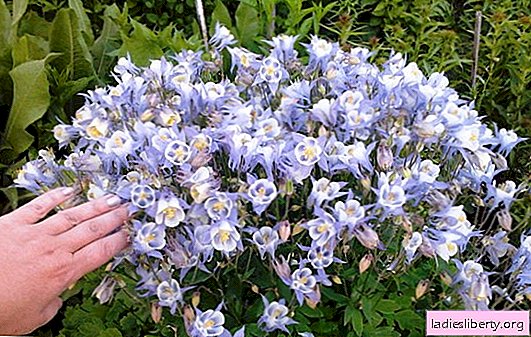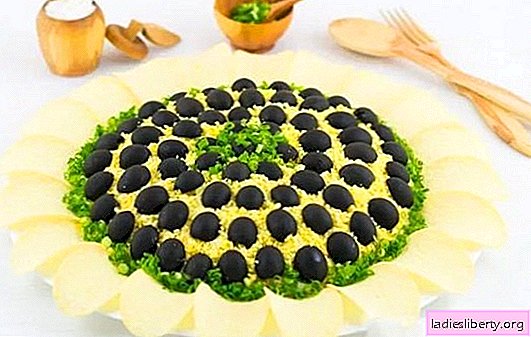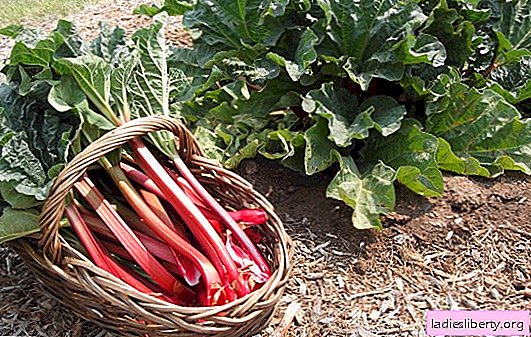
Aquilegia is a beautiful and unpretentious flower that requires minimal care.
In our area, hybrid varieties of aquilegia are grown, of which there are more than 120 varieties.
These plants look more attractive than their wild relatives.
Landing aquilegia
Successful cultivation of aquilegia depends on the right location and soil.
In the garden she needs to allocate a suitable plot. Aquilegia prefers sparse shade and grows well near shrubs. But areas in a dense shadow will affect the flowering of the plant: the brightness of the colors will fade, and the size of the flowers will be smaller.
Aquilegia grows well in gardens with loose and nutritious soil, although it can also develop on poor soils. The flower does not tolerate stagnation of moisture near the horses, so the soil is well drained before planting. Wells are seasoned with humus or compost.
Seedlings are placed at a distance of 40 cm from each other. For 1 square. m. area accommodate up to 10 plants.
How to care for aquilegia?
In open ground, aquilegia care consists of weeding, regular watering and top dressing.
Weeding and loosening soil
One of the prerequisites for growing aquilegia is the absence of weeds. Regular weeding and loosening of row-spacing not only help to combat weeds, but also increase soil aeration.
Watering mode
Aquilegia refers to drought tolerant plants, but you should not forget about watering. In the hot season, the flower needs timely, but moderate watering. Excessive soil moisture causes various diseases.
Top dressing
To grow a healthy plant that is able to fully bloom, you can only apply fertilizers.
In the warm season, it is useful to feed aquilegia several times. When planting, organic fertilizers are added, and the next year the flower is fed with a complex of minerals. Experienced gardeners recommend annually adding a new fertile layer of earth under each bush.
Important! In one place, the flower is grown no more than 5 years. To prevent spontaneous pollination, the collected seeds are planted separately.
Flowering Aquilegia Care
The beginning of flowering in all varieties occurs at different times, the early species bloom in June. Aquilegia bloom is very spectacular. Most varieties have long spurs on flowers painted in bright colors. Flowering of two-tone varieties looks more exotic.
In open field, aquilegia care allows you to extend flowering, which lasts no more than a week. Faded shoots are removed, which preserves the decorativeness of the planting.
The use of additional fertilizing during this period allows you to enjoy flowering until the fall. Full-fledged phosphorus-potash fertilizers contribute to the development of large peduncles.
How is aquilegia propagated (photo)?
The favorite flower propagates in several ways:
• sowing seeds in open ground;
• growing seedlings;
• cuttings;
• division of an adult bush.
Sowing seeds in open ground
Sowing the collected seeds is carried out in the fall, which provides friendly spring seedlings. Natural stratification of seeds improves their germination by several times.
In the spring, they sow prepared seeds on frozen ground. The first shoots will appear no earlier than 25 days. The optimum temperature for the development of seedlings is 18 degrees.
We grow seedlings of aquilegia in indoor conditions
Growing seedlings allows you to get a flowering instance much ahead of time. It is noted that such plants are more resistant to the vagaries of the weather. Sowing seeds for seedlings requires more time and special skills.
Sowing is carried out not earlier than March. The first shoots can be expected in two weeks. The optimum temperature for seed germination is considered to be fluctuations in the range of 16-19 degrees.
The soil for seedlings should consist of turf soil and leaf humus, with the addition of sand. The substrate is placed in cassettes, compacted well and moistened with water. Seeds are evenly distributed on the surface of the earth without seeding them.

Seedlings are carefully watered, avoiding waterlogging of the earth. Excess moisture leads to a number of diseases that will destroy all plantings. In the phase of two real leaves, the seedlings are picked in separate cups, as a rule, this occurs a month after cultivation. Plants are planted in a permanent place only with the onset of heat, around May.
Aquilegia seedlings quickly take root, thanks to good care, flowering can begin in the same year.
Cutting of Aquilegia
Decorative varieties of aquilegia lend themselves well to cuttings. Suitable shoots break out from the bush and land in the greenhouse. Pure river sand is used for rooting. Cuttings are placed so that the daytime sun does not fall on them. It is better to choose a shaded area. Seedlings are regularly ventilated and irrigated.
Division of the adult bush
This method is used extremely rarely. Aquilegia has a deep root system and fragile shoots, which complicates the work with them.
The division of the bush is carried out in spring or early autumn. An adult plant is carefully dug up, the roots are washed and the shoots are cut to 7 cm. The cuts are cut with a sharp secateurs so that each has roots and buds. The resulting delenki planted on prepared beds, watered and mulched. At first, seedlings need regular watering, then plants are looked after as usual.

Aquilegia pests and diseases
A tender plant is susceptible to certain pests and diseases. The most common problems include:
• defeat by scoops;
• invasion of aphids;
• the presence of a spider mite;
• nematode;
• development of gray rot;
• various kinds of spotting and rust;
• powdery mildew.
If white plaque and brown spots are detected, the plant is treated with preparations containing sulfur. From various kinds of pests, they are sprayed with complex chemicals.
Aquilegia in the garden (photo): we select neighbors
In garden design, landscaping is widely used with the help of various varieties of aquilegia. Low-growing varieties are used in the design of alpine slides. Miniature bushes look great against the background of stones, reviving the landscape. They combine well in group plantings with saxifrages and other creeping plants. Some gardeners grow compact varieties of aquilegia in flowerpots and balcony drawers.

Tall varieties of aquilegia can be placed in the flower garden, among other perennials. They look great on the background of ferns, astilbe and host. Blooming irises, lupins and cereals help create a bright extraordinary flower garden.

Popular varieties of aquilegia (photo)
In garden design, the most common frost-resistant type of aquilegia vulgaris, which contains many hybrid varieties.
Two-color varieties of aquilegia with red-white, yellow-pink and blue-white colors look unusual.
Hybrid variety "Crimson Star"
Aquilegia "Elena"

Aquilegia "Delictissima"

Flowering of terry forms looks very attractive, the color of the flowers varies from white to raspberry. Large-flowered hybrids with flower diameters up to 11 cm are known.
Grade "Edelweiss"













